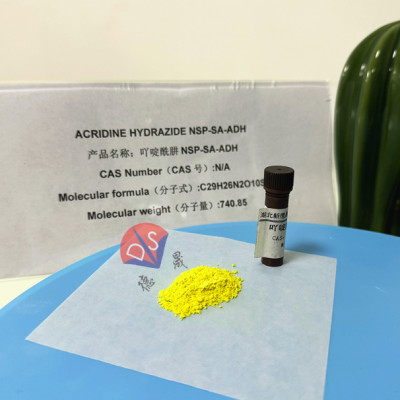Home > Products > Chemiluminescence reagent > The labeling principle and application of acridine hydrazide NSP-SA-ADH
The labeling principle and application of acridine hydrazide NSP-SA-ADH
≥10 Milligram
- 0 Milligram / Milligrams per Month
- Shanghai
- T/T L/C
- 5 days
You May Like
-
Detailed functions and uses of serum separation gel
-
Sodium heparin, a specialized additive for blood glucose test tubes
-
How to detect electrolytes with lithium heparin
-
Precautions for using anticoagulant EDTA dipotassium
-
Manufacturer of blood collection tube additive EDTA tripotassium
-
Spot supply of blood coagulants
Product Details
| Application | Scientific Research | Usage | Laboratory Reagents, Analytical Reagents, Diagnostic Reagents | |
| Property | Biochemical Reagent | Classification | High Purity Material | |
| Grade | AR |
Product Description
In the fields of chemistry and biology, chemiluminescence technology has become a powerful assistant for researchers due to its high sensitivity, fast response, and no need for external light sources. Among them, acridine hydrazide NSP-SA-ADH, as a chemiluminescence reagent, is attracting increasing attention due to its unique labeling principle and wide application prospects.
The labeling principle of acridine hydrazide NSP-SA-ADH
Acrylamide hydrazide NSP-SA-ADH is a fluorescent label based on the acridine structure, which endows it with excellent fluorescence performance and biocompatibility due to its chemical structure. During the labeling process, NSP-SA-ADH binds to biomolecules (such as proteins, nucleic acids, etc.) through specific chemical reactions, forming stable fluorescent complexes. This binding method ensures the fluorescence characteristics of the marker while avoiding interference with the function of biomolecules.
Specifically, the labeling principle of NSP-SA-ADHD mainly includes the following steps:
1. Selecting target biomolecules: Researchers need to choose suitable biomolecules as marker objects based on their research objectives. These biomolecules can be proteins and nucleic acids within cells, as well as receptors and ion channels on the cell membrane.
2. Chemical reaction binding: Utilizing the active groups on NSP-SA-ADH to chemically react with specific functional groups on biomolecules, forming stable fluorescent complexes. This binding method has high specificity and selectivity, ensuring that the marker is accurately labeled on the target biomolecule.
3. Fluorescence signal detection: Fluorescence signals emitted by labeled biomolecules are detected using instruments such as fluorescence microscopy and flow cytometry. These fluorescent signals can reflect the position, quantity, and dynamic changes of biomolecules, providing important experimental data for researchers.
Application of Acrylaminoyl Hydrazide NSP-SA-ADH
As a novel fluorescent marker, NSP-SA-ADH has broad application prospects in the field of biological sciences. Here are several typical application cases:
1. Protein interaction research: By labeling different proteins, researchers can study the interaction relationships between them. For example, proteins labeled with NSP-SA-ADH can be used to detect the binding state between proteins through fluorescence resonance energy transfer (FRET) technology, thereby revealing the mechanism of protein interactions.
2. Cell imaging and localization: NSP-SA-ADH can be used to label specific proteins or nucleic acids within cells, achieving cell imaging and localization. This technology can help researchers observe the distribution, movement, and interactions of biomolecules within cells, providing strong support for cell biology research.
3. Disease diagnosis and treatment: In the medical field, NSP-SA-ADH can be used to label target substances such as tumor cells and pathogens, achieving early diagnosis and correct treatment of diseases. For example, by labeling specific receptors on the surface of tumor cells, researchers can develop targeted drugs that target these receptors, improving the specificity and effectiveness of treatment.
4. Drug screening and evaluation: NSP-SA-ADH can also be used for drug screening and evaluation. By labeling the target molecules of drug action, researchers can monitor the binding between drugs and target molecules in real time, evaluate the efficacy and safety of drugs.
Hubei Xindesheng Material Technology Co., Ltd. produces chemiluminescent reagents such as acridine hydrazide NSP-SA-ADH with a purity of over 98%, good water solubility, stable process, and small batch differences. They are highly trusted and recognized by users both domestically and internationally. If you have any purchasing needs in the near future, please feel free to contact me or click on the official website for more details!
Contact Us

- Hubei New Desheng Material Technology Co., Ltd
- Contact nameDoris Yang Chat Now
Product Categories
| Additive for blood collection | Biological buffer | Chemiluminescence reagent | Chromogenic substrate |
New Products
-
How to choose high-efficiency coagulant powder and coagulant suspension?
-
Factors affecting the silicification effect of water-soluble silicification agents on blood collection tubes
-
Potassium oxalate as an additive for blood collection tubes
-
Sodium citrate anticoagulant tube for coagulation testing
-
What is the use of the new Trinder's reagent TOOS 82692-93-1?
-
Application Introduction of TOPS Color Reagent (CAS40567-80-4)
-
What applications can the chromogenic substrate ADOS 82692-96-4 be used in?
-
What are the advantages of using ADPS 82611-88-9 as a chromogenic substrate?
-
Application of color reagent ALPS 82611-85-6 in biochemical experiments
-
Preparation and Use of New Trinder's Reagent DAOS 83777-30-4 Solution
-
Advantages of HDAOS 82692-88-4 as a chromogenic substrate in Desheng
-
What is the function of the chromogenic substrate MADB 209518-16-1?
-
What are the advantages of the chromogenic substrate MAOS (CAS82692-97-5)?
-
The role of TODB 127544-88-1 in blood lipid testing kit
-
Desheng can supply high-quality luminol raw materials
-
Which is a good place to buy Luminol Monosodium Salt (20666-12-0)
-
Chemiluminescent reagent isoluminol factory direct sales
-
Luminescence analysis of high-purity acridine ester NSP-DMAE-NHS 194357-64-7
-
Direct chemiluminescence of acridine ester DMAE-NHS 115853-74-2
-
Detailed introduction of luminescent reagent NSP-SA 211106-69-3
-
Precautions for using chemiluminescence reagent acridine salt NSP-SA-NHS 199293-83-9
-
Detailed Introduction to Acridoyl Hydrazide NSP-SA-ADH
-
What are the functions of luminescent reagent acridine ester ME-DMAE-NHS?
-
What factors determine the performance of biological buffer TRIS 77-86-1
Popular Searches
Recommended Products
- Stability and precautions of acridine ester (NSP-SA-NHS)
- Detailed introduction of luminescent reagent NSP-SA 211106-69-3
- Direct chemiluminescence of acridine ester DMAE-NHS 115853-74-2
- Luminescence analysis of high-purity acridine ester NSP-DMAE-NHS194357-64-7
- Isoluminol reagent for chemiluminescence
- Introduction and Precautions of Luminol Monosodium Salt 20666-12-0
- Analysis of Luminol 521-31-3 Chemiluminescence Characteristics
- Performance characteristics and usage instructions of color developing substrate DA67 115871-18-6
- Advantages and characteristics of the chromogenic substrate DA64 (115871-19-7)
- The role of chromogenic substrate TODB 127544-88-1 in triglyceride detection
- Application of MAOS 82692-97-5 in In Vitro Diagnostic Kit
- Application of MADB 209518-16-1 in Serum Muscle Enzyme Detection Kit
Find Similar Products By Category
- Chemicals > Chemical Reagent
Product Tags:
- Please Enter your Email Address
- Please enter the content for your inquiry.
We will find the most reliable suppliers for you according to your description.
Send Now-
 Doris Yang
Welcome to my shop, I'm glad to serve you. Please feel free to send me any questions you may have.
Doris Yang
Welcome to my shop, I'm glad to serve you. Please feel free to send me any questions you may have.
Your message has exceeded the limit.
- Contact supplier for lowest price
- Customized Request
- Request Sample
- Request Free Catalogs
Your message has exceeded the limit.
-
Purchase Quantity
-
*Sourcing Details
Your inquiry content must be between 10 to 5000 characters.
-
*Email
Please enter Your valid email address.
-
Mobile






